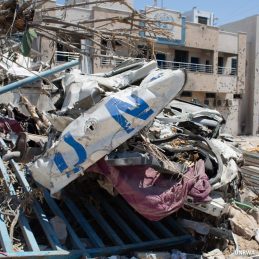GAZA, (PIC)
Nearly eight months after the Israeli genocidal war on the Gaza Strip, donkey-drawn carts have become the most common means of transportation at a high cost.
Among the many crises facing Palestinians in Gaza, the transportation crisis stands out as a reflection of the fuel shortage, destruction of roads, and the risks of vehicle targeting.
On the first day of the genocidal war, Israeli forces closed Gaza’s crossings and blocked fuel entry. Later, they allowed minimal amounts of fuel to enter at infrequent intervals through the United Nations for humanitarian purposes, such as partially operating hospital generators, ambulances, and water wells.
Due to this policy, most vehicles have turned into immobile metal hulks, although some were briefly revived using available cooking oil.
Return to primitive modes of transport
A PIC reporter pointed out that Gazans are deprived of their right to travel by car due to the Israeli fuel blockade. Consequently, most residents rely on walking, animal-drawn carts, and bicycles for transportation.
Ahmed Abu Al-Atta, who works at Al-Aqsa Martyrs Hospital in Deir Al-Balah, has to walk long distances daily to get to work due to the lack of transportation. He explained to the PIC that he walks from Deir Al-Balah refugee camp to Al-Aqsa Martyrs Hospital every day, back and forth.
Donkey carts dominate
Bilal Al-Osta, a 42-year-old displaced from Gaza City to the central governorate, complains about the high cost of transportation via animal-drawn carts. He pays 5 shekels to travel from the Nuseirat camp (central Gaza) to Deir Al-Balah (also central Gaza), nearly double what he used to pay for taxi rides. Despite this, he cannot do without the “cart,” as it has become the main mode of transport in the Strip.
He adds, “We use animals as a means of transport to meet our daily needs. Everything is scarce in Gaza due to the ongoing Israeli siege.”
Al-Osta pointed out that the fuel shortage at filling stations has caused a paralysis in transportation, forcing thousands of taxis to stop operating and be replaced by carts.
He emphasized the importance of these carts, noting their role in evacuating the injured and the dead from areas targeted by the Israeli occupation, especially in Gaza City and the northern regions.
With their increased use, the prices of donkeys in Gaza have risen, making them a source of income for many families. The carts are used to transport people during displacement and to move from displacement areas to hospitals or aid distribution points.
Transport sector losses
Meanwhile, Palestinian Minister of Transportation Tarek Zaarab revealed that Gaza’s transportation sector has suffered losses exceeding 3 billion dollars due to the Israeli war.
He said that “committees of the Ministry of Transportation estimate that the Israeli forces destroyed about 55,000 vehicles in Gaza, which is about 60% of the licensed vehicles in the Strip.”
He added that the losses in Gaza’s transportation sector “exceeded 3 billion dollars, including infrastructure and citizens’ vehicles.”
He further noted that “the occupation destroyed about 945 km of roads in Gaza, which is 65% of the road network, with a cost exceeding 2 billion dollars.”















